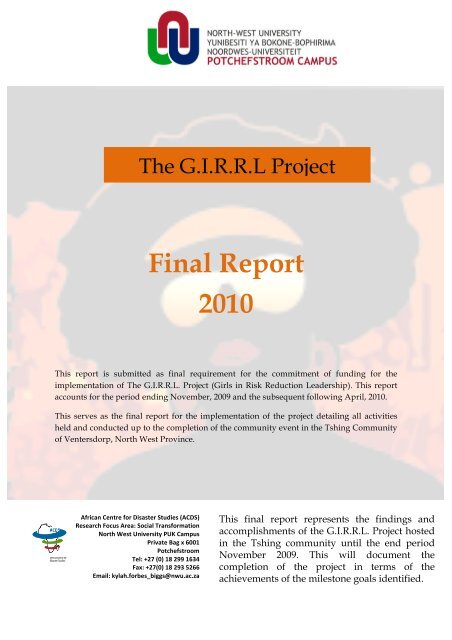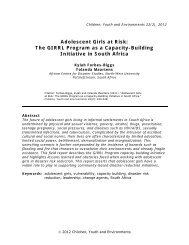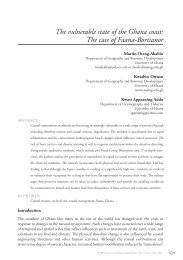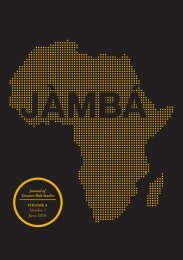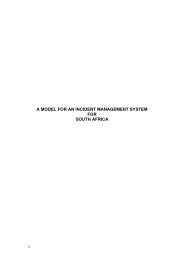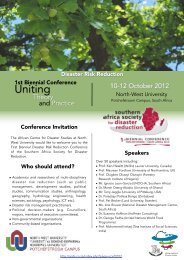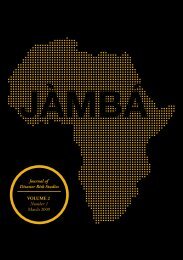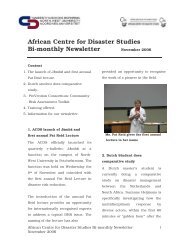Download full pdf version - African Centre for Disaster Studies - NWU
Download full pdf version - African Centre for Disaster Studies - NWU
Download full pdf version - African Centre for Disaster Studies - NWU
- No tags were found...
You also want an ePaper? Increase the reach of your titles
YUMPU automatically turns print PDFs into web optimized ePapers that Google loves.
The G.I.R.R.L ProjectFinal Report2010This report is submitted as final requirement <strong>for</strong> the commitment of funding <strong>for</strong> theimplementation of The G.I.R.R.L. Project (Girls in Risk Reduction Leadership). This reportaccounts <strong>for</strong> the period ending November, 2009 and the subsequent following April, 2010.This serves as the final report <strong>for</strong> the implementation of the project detailing all activitiesheld and conducted up to the completion of the community event in the Tshing Communityof Ventersdorp, North West Province.<strong>African</strong> <strong>Centre</strong> <strong>for</strong> <strong>Disaster</strong> <strong>Studies</strong> (ACDS) Research Focus Area: Social Trans<strong>for</strong>mation North West University PUK Campus Private Bag x 6001 Potchefstroom Tel: +27 (0) 18 299 1634 Fax: +27(0) 18 293 5266 Email: kylah.<strong>for</strong>bes_biggs@nwu.ac.za This final report represents the findings andaccomplishments of the G.I.R.R.L. Project hostedin the Tshing community until the end periodNovember 2009. This will document thecompletion of the project in terms of theachievements of the milestone goals identified.
The G.I.R.R.L. Project - Final-Term Report – Submission May 2010 2CURRENT ACCOMPLISHMENTSTo the report date the project has success<strong>full</strong>y completed the final component of the projectimplementation phase. This phase is the follow up to the session implementationdocumented in the mid-term report submitted at the mid stages of work. Within this sectiona number of core activities demarcated as the ‘project milestones’ were identified andfinalized.Based on the original plans which were anticipated, the stakeholder meeting would beconducted as defined by the lessons learned and critical observations made in the MaquassiHills Project. This initial decision would serve as a means to host a collaborative andproactive workshop rather than a briefing meeting. This again was designed to maximizethe contributions of the stakeholder body while minimizing the time demands on them toattend meetings regarding matters on which they have already been introduced to in detailsat the commencement of the project.However, due to the immense timeline constraints and with the project finishing so late inthe year just be<strong>for</strong>e the Christmas holiday period, it was deemed to be ineffectual to host afinal stakeholder session <strong>for</strong> feedback when such low stakeholder turnout would beguaranteed by the timing. Instead the situation was analyzed and at that point a decisionwas made to avoid the stakeholder meeting in lieu of the progress being made to adopt theproject into the scope of local interest. What was openly communicated and observed wasthe inherent and unprompted actions of local stakeholder bodies to join with theparticipants and create opportunities <strong>for</strong> collaboration or support. Even the participantsthemselves made the decision to expand the ideals of project within their school in order toinvolve other female students in G.I.R.R.L. Project classes as a means of spreading thebenefits to others.In attempt to observe if this approach is sustainable, the project management has beenfollowing the progress of the girls and the stakeholders to ensure that the expectations ofproject continuity were being maintained. The close proximity to Potchefstroom (the projectmanagement centre) allows to <strong>for</strong> easier communication with stakeholders and participantsin order to monitor the situation despite the closure of the <strong>for</strong>malized project.
3STAKEHOLDERSDespite initial decisions to host the stakeholder meeting at the beginning of December 2009in line with similar experiences in Phase 1 of the project hosted in Maquassi Hills(Wolmaransstad), observed changes in the flow of the project created an opportunity toobserve the natural interest created within the community. Instead of being prompting toparticipate in <strong>for</strong>malized meetings, many of the stakeholders took pro-active positionsfollowing the community event to involve the participants in local projects or contact withthem.Ordinarily the purpose of the stakeholder workshop serve to create an opportunity tobrainstorm ideas <strong>for</strong> the community to conceptualize possible roles <strong>for</strong> participants tobecome involved in the initiatives of local departments, NGOs or within the school itself. Itis ultimately a sounding board where discussions are held and suggestions are made <strong>for</strong>community representatives to promote their institution and visuals places <strong>for</strong> trainedparticipants to give back to the community through service and support.Stakeholders Identified and Involved:Mr. Victor Mogonediwa – Thuto Boswa High School (Principal)Ms. Elona Masote – Thuto Boswa High School (Life Skills Teacher)Cllr. Mojahi– Mayor’s Office Ventersdorp (Local Gender Department)Mr. Tseko Marake – Youth Center Ventersdorp (Manager)Ms. Puleng Motaung – Department of Health (Reproductive Health & HIV)Ms. Belinda Madikizela – Kenneth Kaunda District Municipality <strong>Disaster</strong> CenterMr. T.J Swarts – Fire Department VentersdorpMr. Solomon Mere – Love Life VentersdorpMs. Nthabiseng Mataboge – Department of Social Development Ventersdorp (SocialWorker)Ms. Gwiji – Mayor’s Office Kenneth Kaunda District MunicipalityIn particular, Tseko Marake and Solomon Mere have been particularly active in recruitingparticipants to become involved in youth based activities in Ventersdorp. Mr. Mogonediwaand Ms. Masote’s support of the participants in their desire to <strong>for</strong>m a “G.I.R.R.L” Clubwherein in<strong>for</strong>mation was passed to other students with the project girls taking on their rolesas leaders to others in their school. Ms. Madikizela also invited the participants to partake ina youth paraffin safety training session held in April 2010 <strong>for</strong> addition specialized training tohelp them spread knowledge and build more resilient communities. Ms. NthabisengMatoboge has taken on a significant role not only as a local supporter of the girls in terms offollow-up care and advice but has also been a role model <strong>for</strong> many who identifiedaspirations of pursuing careers in social work.
The G.I.R.R.L. Project - Final-Term Report – Submission May 2010 4FACILITATORSThirty (30) facilitators from various sectors took part in presenting the various sessionsacross the span of the project. The advantage of having more time to plan and the closerproximity to the base of our operations, compared to the previous Maquassi Hills’ Project,helped to encourage repeated support from facilitators to investigate local persons andfacilitators from previous projects.FACILITATORSORGANIZATION/DEPARTMENT/AGENCYSESSION TOPICRene Phethlu <strong>NWU</strong> Department of Nursing Mental Health and CopingStrategiesCpt. Adele Myburg South <strong>African</strong> Police Services(Potchefstroom)Personal Safety and SelfDefenceElize Harris <strong>NWU</strong> Department of Education Environmental AwarenessToto Tshona Student <strong>NWU</strong> Dept of Education Environmental AwarenessProf van Rensburg <strong>NWU</strong> Dept of EnvironmentalSciencesEnvironmental ExcursionJames MothosolaNkele Mothosola<strong>NWU</strong> HIV/AIDS ProgrammeCounselorPeer Education (SexualHealth)Puseletso Lebitso<strong>NWU</strong> HIV/AIDS ProgrammeTiro Swarts (Fire Chief) Fire Department Ventersdorp <strong>Disaster</strong> Planning andCommunity MappingJohn TsagaeFire SafetyFrederick KrugerNzingo BantsejangSamuel MathopeMariette Swanepoel <strong>NWU</strong> Department of Biokinetics Physical Health*Tseko Marake Ventersdorp Youth Center Community Involvement*
5Nthabiseng MatabogeSolomon MerePuleng MotaungDept of Social DevelopmentLove LifeDepartment of HealthInstructor Global Learning Services Buddy AidCatrien Louw<strong>NWU</strong>CommunicationEffective CommunicationMarike WilliamsDepartmentYolanda MaartensKristel Fourie<strong>African</strong> <strong>Centre</strong> <strong>for</strong> <strong>Disaster</strong><strong>Studies</strong> (ACDS)Kylah Forbes-Biggs <strong>African</strong> <strong>Centre</strong> <strong>for</strong> <strong>Disaster</strong><strong>Studies</strong> (ACDS)<strong>Disaster</strong> Planning andCommunity MappingMarliaan Erasmus <strong>NWU</strong> Career <strong>Centre</strong> Positive thinking, personalevaluation and after schoolskillsElizabeth Mokotsane Dept of Health Family planningHelena Hoogstad<strong>NWU</strong> Dept of Social SciencesPersonal philosophyCandice Kastopolous*Joint sessionTRAINING SESSIONSThe primary responsibilities involved identifying service providers <strong>for</strong> transportation andfood arrangements <strong>for</strong> the project. As such the North-West University TransportationDepartment was utilized based on its easy accessibility and discounted rates <strong>for</strong> universitypersonnel <strong>for</strong> hiring vehicles <strong>for</strong> our travel needs regarding the project. Once again thelogistical planning <strong>for</strong> the project was organized and confirmed prior to the sessions.Catering requirements were identified and arrangements were made with FoodwaysCatering to provide suitable snack packs <strong>for</strong> our participants and facilitators that could behanded out at the end of the sessions.This method was selected rather than <strong>for</strong>mal hot food based on the realization that it wouldbe unfair to ask participants to stay <strong>for</strong> an extended period after the sessions in order to sitand eat a meal. This was primarily to the already high demands on the time <strong>for</strong> homeworkand extra-curricular activities as well as <strong>for</strong> safety reasons (walking home after dark). A finalmenu was prepared with a selection of light and healthy foods, which also served torein<strong>for</strong>ce the benefits of eating a balanced diet.
The G.I.R.R.L. Project - Final-Term Report – Submission May 2010 6The training was launched on 22 nd July 2009 at the Thuto Boswa High School in Ventersdorpwith twice weekly sessions held <strong>for</strong> a combined time of five (5) hours per week.Session 1: Introduction and Team BuildingThe session was lead by the project team and provided an overview of the project, arein<strong>for</strong>cement of the core values (including) and established the foundations <strong>for</strong> effectivedecision-making. Ice-breakers were used to help the participants and the project team togain mutual trust. The girls were asked to define their own project rules which included notolerance <strong>for</strong> late comers, cell phone use, disrespect of others and violence.The schedule was presented in order to help the participants become familiar with theupcoming session topics to also help ensure that they felt at ease with the schedule. Eachparticipant was given a pen and notebook <strong>for</strong> note-taking.The team-building component consisted of various activities with post-activity debriefing asa means of conveying the important lessons concerning teamwork and group dynamics. Alltwenty girls were in attendance <strong>for</strong> the first session. All twenty (20) participants attendedthe first session.Session 2: Team-Building, Decision-MakingThe project team continued this session concluding the team-building component andfollowing on with effective decision-making. The decision-making component wasintroduced with activities selected that encouraged lateral thinking and was rein<strong>for</strong>ced withgroup discussions. All twenty (20) girls attended this session.Session 3: Physical HealthMariette Swanepoel, a biokineticist at the <strong>NWU</strong> Potchefstroom campus returned to host thePhysical Health session. She provided instruction to the girls of a series of exercises (circuittraining) that could be done at home specifically in the small spaces commonly available intownship housing. Each girl also received an exercise elastic as part of the programme thatthey could use to assist in their strength training.Ms. Swanepoel then addressed the issue of nutrition with participants to help buildunderstanding while presenting the importance of nutrition and exercise in supportinggood physical and mental health. This was particularly important based on the incidence ofHIV infections among this group of participants. Many of these participants repeatedly missschool due to related illnesses and subsequent treatment. The need to maintain healthyeating and lifestyles was emphasized as a critical way to help defend against the onset ofopportunistic infections and to improve T-cell counts. All twenty (20) girls completed thephysical health session.
7Session 4: Mental Health and Coping StrategiesMs. Rene Phethlu from the Nursing School at North-West University (<strong>NWU</strong>) Potchefstroomcampus was invited back to conduct this session. Group discussions were the primary<strong>for</strong>um of learning wherein various topics concerning mental health were introduced. Theterm <strong>African</strong>ism was defined and discussions evolved regarding determination, confidenceand life expectations. Based on experiences from the previous site a strong emphasis wasplaced on rape as a critical issue needing more attention within communities. In the weeksfollowing this session one of the participants approached the Project Coordinator regardinga friend who had recently been raped.Although the facilitator’s discussion was enjoyed the project team gathered that there wasnot as much focus on coping strategies <strong>for</strong> example - how to handle death of a familymember or how to recognize depression or similar affective illnesses. The session waspresented more as a motivational session despite our original requests <strong>for</strong> thea<strong>for</strong>ementioned content. It has been decided that further assistance will be sought from acommunity social worker that can provide more practical tools <strong>for</strong> these girls to staymentally healthy in the circumstances that they face. Nineteen (19) girls attended thesession on mental health and coping strategies.Session 5: Personal Safety and Self DefenceThe fifth component was hosted by Capt. Adele Myburg from the South <strong>African</strong> PoliceServices (SAPS) Potchefstroom. Capt. Myburg has a background and personal interest inworking with community awareness programmes and in particular she teaches children andwomen how to be safe by using basic self-defense techniques. Her attitude and ease with thegirls in the Maquassi Hills Project reaffirmed that she was an obvious choice <strong>for</strong>Ventersdorp. She provided in<strong>for</strong>mation on various approaches that could be used to defendoneself and how to use ingenuity in times of threat to overwhelm an attacker. Capt. Myburgalso demonstrated and contextualized escape techniques. Most significantly, issuessurrounding rape were discussed including places of safety, what to do in the event of rape,preserving evidence and procedures <strong>for</strong> conducting a rape kit by local law en<strong>for</strong>cement.Once again this session and its pertinence to rape was quite significant based on the threatsposed to girls in this community. Nineteen (19) girls were in attendance <strong>for</strong> this session.Session 6: Personal Philosophy and evaluationHelena Hoogstad and Candice Kastopolous from the <strong>NWU</strong> Dept of Social Sciencespresented a session on self-evaluation and philosophy of life. Each girl had to draw theimportant things in her life and explained the elements that appeared to the rest of thegroup. The session was presented in a relaxed manner and the girls found it exciting todiscover something new about herself. They learnt about their worldview and the waythings impact their lives. It was a creative session focusing on the use of symbols and soundsas a means of expression. Nineteen (19) girls attended the session.
The G.I.R.R.L. Project - Final-Term Report – Submission May 2010 8Session 7: Career guidanceMarliaan Erasmus tackled the daunting task of enlightening the girls to a world ofopportunity merely by believing in themselves and working hard at school. They evaluatedtheir personality types and matched it with some basic careers <strong>for</strong> going <strong>for</strong>ward. The girlsrealized that they could be anything they want to be, no matter their circumstances, if theywork hard they will succeed. Ms. Erasmus has a true passion <strong>for</strong> assisting the youth andpatiently explained the various career paths that the girls could follow. Even though theymay not be in the matriculation year, it is vital to instill a sense of self-belief from an earlyage. Eighteen (18) girls attended the session.Session 8 and 9: Peer education and Sexual healthThe session was presented by James Mothosola (HIV/AIDS Programme at the <strong>NWU</strong>Potchefstroom campus) with assistance from his wife Nkele Mothosola (a counselor) andPuseletso Lebitso (peer educator from the <strong>NWU</strong> HIV/AIDS programme). The importanceof the G.I.R.R.L Project was discussed within the context of peer support and communityresponsibility. A group discussion commenced regarding risky behavior and the issue ofHIV/AIDS was introduced using various decision-making activities based on the“Scrutinize” campaign whereby the participants were motivated to “Flip HIV to HIVictory”.Due to the reality of HIV within the group, additional attention was given to the role ofjudgment, prejudice and stereotypes in shading the decision-making process. Thecharacteristics of a peer educator were discussed as well as the role of peer educators inschools and communities. Nineteen (19) girls attended this session.Session 10: Family planningThe unique composition of the group of participants called <strong>for</strong> individual attention tospecific areas of their lives. The fact that nine (9) of the girls are heads of household, was ahuge concern to the project team and professional advice was called in. ElizabethMokotsane a community health nurse from the Department of Health has a lot of personaland professional experience regarding the matter. She has been involved with the GIRRLproject <strong>for</strong> over a year now in the Ikageng site and in supporting Maquassi Hills despite herother work commitments. One of the most significant contributions was her ability to step inand explain the importance of ‘responsibility’ to the girls. The fact that most of them are stillvery young and are now faced with adult situations and decision making positions, meantthat they needed the correct advice from someone who has experience and insight. Needlessto say the girls enjoyed the maternal nature of Ms. Mokatsane and she was able to establishthe level of com<strong>for</strong>t needed to allow them open up about the issues in their lives and thestruggles they are faced with on a daily basis. Nineteen (19) girls attended the session.Session 11: Community Involvement
9Seeing as the G.I.R.R.L. Project is a community-based, working within a specific community,it is vital to get the various role-players at local level involved with the girls and plays alarge role in the sustainability of the project. The aim is that each of the variousrepresentatives at this session would be able to utilize the girls in future and make use oftheir fantastic new skills and capacities. Each facilitator explained to the girls how theycould get involved with their various institutions and emphasized the fact that volunteeringat local level could open up many doors in future. Nineteen (19) girls participated in thissession.Session 12: Social and personal issuesDue to the delicate issue of suicide that was raised by a few of the girls and the un<strong>for</strong>tunateexperience of one of the participants who discovered her deceased brother in the familyduring the course of the project this topic was included and emphasized in the discusssions.This emphasized the need to address this issue and other aspects in the girls’ lives that couldmake them feel depressed, alone and desperate. Nthabiseng Mataboge from the Departmentof Social Development was sought as one of the dynamic social workers from theVentersdorp area as a local facilitator. In her experience she has become familiar with manyof the stressors and strains that challenge the participants on a daily basis. By making use ofa group discussion setting, the girls analysed the various scenarios leading to suicide andMs. Mataboge assisted them in identifying coping mechanisms when they are faced with asocial or personal issue or problem. Fifteen (15) participants attended the session.Session 13: <strong>Disaster</strong> ManagementThis session was presented by Mr. Tiro Swarts from the Ventersdorp Fire Department andthe PIER Project. The objectives of the session were to introduce basic concepts withindisaster studies to the participants in a manner, which reflected their level education, socialcontext and degree of understanding. The session focused around a group discussiondesigned to explain disasters, hazards, vulnerability and risk within the context of the livesof the girl participants within their community. Eighteen (18) girls attended this session.Session 14: Fire SafetyThe session was presented by Mr. John Tsagae, a fire fighter at the Ventersdorp FireDepartment with support from Mr. Dikane from the Potchefstroom Fire Department. Thefire fighters at the station also assisted in the presentation detailing the handling of theequipment, and displaying the uni<strong>for</strong>m worn by fire fighters <strong>for</strong> use during house and veldtfires. Mr. Dikane presented in<strong>for</strong>mation regarding fire and paraffin safety and howparticipants can volunteer <strong>for</strong> public awareness initiatives. The session was held onsight atthe Ventersdorp fire station. All twenty (20) girls attended this session.Session 15: Environmental Awareness
The G.I.R.R.L. Project - Final-Term Report – Submission May 2010 10This session was presented by Ms. Elize Harris who is a lecturer at the Education Faculty, inthe area of Environmental Awareness. The objectives <strong>for</strong> the session were again; to createawareness on local environmental issues, to stimulate dialog and co-operation among thegirls in order to create a new lifestyle which is based on meeting everyone’s needs,explaining and discussing Recycle, Re-use and Reduce principles and exploringentrepreneurial opportunities regarding the use of waste materials. The objectives weresuccess<strong>full</strong>y met by having discussions on the various subjects. The girls then made photoframes from recycled waste materials. At the community event, each girl will receive apicture taken during the project in her frame. A student teacher, Toto Tshona also attendedthe session and helped to motivate the participants as young women to be strong and makepositive choices in their future. Nineteen (19) girls attended this session.Session 16: Environmental ExcursionProf Leon van Rensburg arranged an excursion where the girls were taken to Rustenburg.Here they visited the Impala Platinum mine and met the inspirational group of ladies ofMononsa Fertilizer. Their passion <strong>for</strong> the environment was infectious and they reallyshowed the girls a lot about making compost and explained how easy it was to start thisinitiative at home. The day was such a success that they did not want to leave. Prof vanRensburg showed the girls horrific images and shared scary statistics relating to pollutionand waste in South Africa and explained the effect this has on our society. The day was ahuge success, thanks to Prof van Rensburg and the team at Mononsa Fertilizer. All twenty(20) girls went on the excursion to Rustenburg.Session 17: First Aid TrainingAn instructor from Global Learning Services in Klerksdorp trained the participants inBuddy Aid. The participants gained certification in Buddy Aid and are recognized with thisdesignated <strong>for</strong> a period of three (3) years. This session was presented over two (2) days andnineteen (19) and eighteen (18) participants attended these two days respectively.Session 18: <strong>Disaster</strong> Planning and Community MappingKylah Forbes-Biggs in her presentation introduced central concepts to disaster riskreduction including ‘disasters’, ‘vulnerability’, ‘hazards’ and ‘risk’. These terms wereexplained within the context of Ventersdorp and particularly with significance to the targetaudience of the participants. Community risk assessment activities were conductedincluding hazard ranking exercises, problem trees, community mapping, communitytimelines which helped to contextualize the relevance within the community. The problemtree activity ensured the understanding of the root causes and implications of the hazardsidentified by the ranking activities. The hazards that the participants’ identified as criticalthreats to their welfare were crime, drug abuse and HIV/AIDS. Secondary issues that thegirls identified related to alcohol abuse and teenage pregnancy. Community map drawingwas central to establishing an appreciation of how the participants view their communityand recognize the resources, threats and assets available in the area. Community timelines
11were conducted to help understand how the community developed within across thelifespan of the participants. All twenty (20) participants attended this session.Session 19: Effective Communication: Audience and Listening skillsCatrien Louw and Marike Williams presented the audience analysis session. Theparticipants learnt what different audiences exist, how to adapt a message <strong>for</strong> a specificaudience and discussed what audience they will potentially target when it comes to theircommunity event. The listening skills section was presented by Kristel Fourie whoemphasized the importance of good listening skills, as most communication problems relateto poor listening which leads to misunderstandings. All twenty (20) participants attendedthis session.Session 20: Effective Communication: Professionalism, Leadership and G.I.R.R.L. powerYolanda Maartens presented the professionalism, leadership and the G.I.R.R.L. ‘power’component, which helped the girls to realize that they are both ladies and leaders withintheir community. Their role as role models was emphasized and they learnt all about goodleadership and what makes a leader. The ability to draw on inner strength and build teamspirit through the G.I.R.R.L. ‘power’ session which was also presented in this session. Alltwenty (20) participants attended this session.Session 21: Community Event PlanningThe community event is held in order to share what the participants have learnt and plays avital role in in<strong>for</strong>mation dissemination to both stakeholders and community members. Theparticipants had to identify their audience based on who they thought would benefit themost from what they have learnt throughout the project. The girls based their ideas on thehazards that they had identified and ranked within their community, as was done duringthe community-based disaster planning session with Kylah Forbes-Biggs. In the end it wasdecided that the participants would have the event in Extension 2 within the TshingCommunity Hall. This was an accessible location <strong>for</strong> stakeholders, participants andcommunity members alike. Sixteen (16) participants attended this session.Community Event Practice Session 1The final ideas were shared regarding the community event and the following activitieswere jointly decided on: a drama dealing with alcohol and drug abuse, touching on violenceand crime. Three poems would also be presented by three of the participants focusing onunplanned pregnancy, violence and crime and drug abuse respectively. The participantsclearly knew what they wanted to do and worked on their very own G.I.R.R.L. project song.Nineteen (19) participants attended the practice session. This was one of two practice
The G.I.R.R.L. Project - Final-Term Report – Submission May 2010 12sessions where the G.I.R.R.L. project team was present, the rest of the time the girls practicedindependently.Community Event Practice Session 2The second practice session was held at the venue (Extension 2, Community Hall) so that theparticipants could practice on stage, see how they would enter the stage and arrange thelogistics of the actual per<strong>for</strong>mance. Fifteen (15) participants attended this practice session.Community Event Dress RehearsalA dress rehearsal was held at the community hall. This was a very successful session as theparticipants were well rehearsed. Final touches were made to the poems and theparticipants presented their project theme song with pride. All twenty (20) participantsattended the dress rehearsal.COMMUNITY EVENT: 28 November 2009The community event was held on the 28 th of November 2009 and can be considered a hugesuccess. This could not have been achieved without the help of the <strong>Disaster</strong> <strong>Centre</strong> and theKenneth Kaunda District Municipality. The girls decided on the content of the communityevent. Crime, drug abuse, violence, alcohol abuse, HIV/Aids and unplanned pregnancywere the main themes identified.These themes were presented in a number of ways. Participants devised a drama, whichwas used to touch on the issues of crime, drug and alcohol abuse and HIV/AIDS. Threepoems, authored by the participants were also presented focusing on the issues ofunplanned pregnancy, violence and crime and drug abuse.Overview of the Community EventThe Dr. Kenneth Kaunda District Municipality was responsible <strong>for</strong> inviting the VIPs fromgovernment and arranged the catering in a tent outside the hall. This worked very well.The attendance was excellent and each participant invited fifteen (15) friends and familymembers. All the stakeholders of the project and facilitators were invited. The attendancewas approximated at close to three hundred persons.Yolanda Maartens, project manager <strong>for</strong> the Thuto Boswa project and Councilor Dlamini(MMC of <strong>Disaster</strong> Risk Management) presented the welcome address. Speeches wereprovided by a representative of the Mayor of the Kenneth Kaunda District Municipality,Prof. Dewald van Niekerk of the <strong>African</strong> <strong>Centre</strong> <strong>for</strong> <strong>Disaster</strong> <strong>Studies</strong> and Mrs Elona Masotefrom Thuto Boswa secondary school. Pastor Mosenogi opened the ceremony with a prayer.
13The participants entered onto the stage singing their chosen theme song: “Lean on me” andwere followed by Sky Boyz who entertained the audience with dancing. The participantspresented a drama, which was followed by the Baitswingwao Cultural Group. Thefollowing participants then presented their poems to the audience: Kefilwe Morake, FloraLeeto and Emily Kgarudi. The participants ended their event by singing their very ownG.I.R.R.L. power song. This was followed by the prize giving and award ceremony.PARTICIPANTSDuring the selection process, the life skills teacher Mrs. Masote, was of immense value asshe showed true insight and understanding of the social issues faced by the girls. In the endthe decision was taken to work with a group of girls, irrespective of their age, between thegrades 8 and 11. Thus although some of the girls may already be twenty and twenty oneyears of age, none were in their matriculating year as it was found in previous projects thatthe participants battle to attend each session as they have exams and additionalpreparations. A prevalent issue in this area was the age diversity of students wherein manystudents were much older than standard age guidelines would expect. Ordinarily girls ofthis age range would have completed school and likely be in a position to seek employment.Nine of the girls are heads of households, which meant that they are faced additional socialpressures beyond that of the average high school girl. These additional pressures andresponsibilities, though difficult to eradicate in such a project was discussed and addressedin the content of the sessions based on its overwhelming contribution to social vulnerabilitywithin South <strong>African</strong> society.HIV/AIDS is a prevalent social issue within the community surrounding Thuto Boswa andthe high prevalence of HIV infections re-emphasized the realization that many our girls maybe faced directly with issues relating to HIV/AIDS (whether personal infection or infectionwithin the family unit). Although attendance has been excellent, those girls who were absentat times cited illness and treatment as their reasons. It is clear that the girls in thecommunity were not scared to speak freely regarding their treatment and felt com<strong>for</strong>tablewith the facilitators and project manager to discuss personal matters.The participants of the G.I.R.R.L. Project Thuto Boswa are extremely committed andattendance has been superb since the start of the project. Although they are not originallyaffiliated as friends, they managed to act amiably and deal with conflicting views ratherwell. Overall the participants have been eager to participate and learn, they are veryindependent and have the potential of becoming great leaders in their community.SUMMARYThe project was completed in relatively good time based on the constraints of school andnational holidays, exam periods and limited meeting times due to school hours. Theprimary alteration to the project implementation was regarding the stakeholder workshop
The G.I.R.R.L. Project - Final-Term Report – Submission May 2010 14which was minimize in significance based on the students and stakeholders own interestand drive to investigate and create opportunities <strong>for</strong> collaboration and support within theirvarious sectors. Contact will be kept with the various stakeholders.We have had strong support from the school including the life skills teacher and theprincipal. Our participants have been eager to engage in discussions and were well-behavedin the sessions. Some of the HIV positive participants have been struggling to attendsessions because of their regimented medical treatment at the local hospital/clinic howeverdespite their occasional absences they are quite active in the program.All the sessions have been well received by the participants. Attendance was excellentthroughout and the girls showed commitment to the end. The project was well received bythe community and again the community event proved vital when it came to in<strong>for</strong>mationdissemination and also to share the objectives of the project.Most of what the project team has learnt has to do with preparation and participantsensitization and finally the involvement of stakeholders and building sessions to cater <strong>for</strong>the participants’ specific needs. Again it is clear that without the support of the schoolprincipal and staff a project like this would be almost impossible. Overall the project was asuccess and the project follow up (see below) reflects this.PROJECT FOLLOW-UP 2010Through regular contact with participants, the principal, and the life-skills teacher, hasenabled the project team to follow and measure the progress of the project postimplementation.The participants have truly grown since the project and have take own initiative to continuethe project and get more girls involved. The participants now have their own G.I.R.R.L. clubafter school. They have arranged their own classroom and meet 3 times a week after school.Here they revisit what they have learnt, recap some of the sessions and share ideas, talkabout problems, sing songs and just have fun together. This activity is also important as itdistracts them from negative behaviours and mischief which often cases girls to get introuble and end up in even more vulnerable positions through pregnancy, rape and abuse. Itstimulates them to learn and share their knowledge with others girls in similar situationswithin the community which serves as a means of driving social change and ideologies.Where girls see other girls leading by example and taking on leadership roles within theschool and the broader community it creates better opportunities <strong>for</strong> others to also step<strong>for</strong>ward and continue to make great strides.The original participants have now recruited ten (10) new girls as four (4) of the originalparticipants are no longer attending the school have apparently had to relocate out of theVentersdorp area. Although it is sad to think that some of the original participants havemoved, it is excellent to see the enthusiasm in the new members’ faces. Perhaps it presentsthe opportunity <strong>for</strong> other small girl based leadership initiatives to be created in their newlocations based on the experiences shared with G.I.R.R.L. These original participants have
15clearly taken the objectives of the project to heart and are living proof of the success of theG.I.R.R.L. project.Together with the <strong>Disaster</strong> <strong>Centre</strong> the participants attended a paraffin safety day inKlerksdorp and again got the opportunity to further their knowledge and improve theirskills. It is vital that the project team is always in<strong>for</strong>med of such excursions andopportunities, as this is how we measure the sustainability of the project and thecontribution each stakeholder has made. We look <strong>for</strong>ward to working with the <strong>Disaster</strong><strong>Centre</strong> in the near future.Yolanda MaartensProject ManagerKylah Forbes-BiggsProject Coordinator


